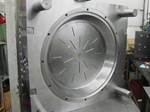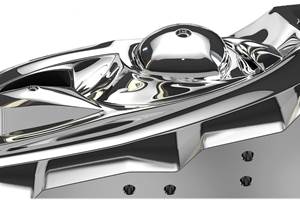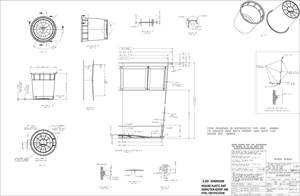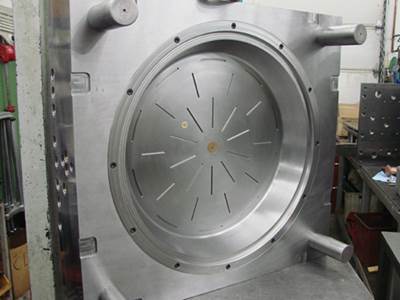Cooling of the Sprue
Using conformal cooling in sprue bushing design may be one solution for reducing cycle times.
Effective mold cooling reduces overall cycle times, improves part quality and decreases scrap rates. Conformal cooling, or the placement of cooling lines equal distances from heated surfaces, is one of the most advanced ways to achieve these results. Improvements in process control, the advent of new technologies and advances in additive manufacturing have allowed the production of tooling and components that take advantage of the benefits of conformal cooling. Sprue bushings are one such type of mold component. This article will show how sprue bushings with conformal cooling could improve cycle times in cold runner injection molding (Figure 1).
Traditional Cooling of the Sprue Bushing
In a cold runner system, the sprue, the extra plastic that remains on the molded part from its filling point, must freeze prior to the part’s ejection from the mold. If the sprue does not freeze, it could stick to the mold cavity and/or deform, and therefore prevent automated sprue pickers from being able to function effectively. In many production lines, cycle time is limited by the time it takes for the sprue to cool. This is often the case in the production of thin-walled parts and parts that are comparable in size to the sprue itself.
In these cases, cooling the sprue faster can directly reduce overall part cooling time. This can greatly impact production efficiency when cooling time is a significant portion of overall cycle time. Because the sprue bushing is the tool component through which the molten plastic flows and forms the sprue, it makes sense to address cooling through this component.
Conventional cooling is accomplished by conduction of heat through the bushing to the rest of the mold by way of a slip fit, in which the mold’s components can be assembled by hand. This fit can lead to poor heat conduction at the interface, however. The bushings can be made from copper alloys to improve their thermal conductivity and increase the rate of heat conduction, but copper’s softness over other metals can result in increased wearing. Because of this, many copper alloy bushings are manufactured with a steel wear insert inside that makes contact with the injection nozzle. This not only helps protect against wear, but also acts as a thermal insulator to the nozzle.
Other more traditional cooling methods, such as using cross drilling and bubbler tubes, require excessive material removal in order for them to be used on such small components (usually 50 mm in outer diameter).
Seeking a Better Way
Finite element analysis (FEA) was used to help predict the performance of different cooling geometries in a mold design. Comparing cooling channel designs is possible through FEA as long as relevant boundary conditions are used. FEA is less useful for comparing actual cycle times, because it requires very accurate modelling conditions and inputs.
In this experiment, FEA was used on both a conventional steel sprue bushing with no cooling channels and one with conformal cooling channels. Cyclic analysis ran for 11 cycles on both sprue bushing types, determining an “equilibrium” cycle with a realistic temperature gradient in the bushing. This step is critical to meaningful FEA simulations of plastics, as the temperature distribution in the mold (both in space and in time) is critical to evaluating the impact of cooling.
Figure 2 shows the cyclic temperature profiles, where the calculated temperature was measured along the centerline of the sprue on the cavity side (opposite of the nozzle side). The cool-down times for the 11th cycle of each sprue bushing are aligned and plotted in Figure 3. The reduction in cooling time, or the Thermal Performance Index (TPI), was calculated based on the percentage reduction of time. The TPI of the conformal-cooled sprue bushing was 53 percent compared to the standard steel sprue bushing. The temperature profiles of both sprue bushing models are compared in Figure 4, showing a noticeably lower average temperature for the conformal-cooled component.
Analyses were also run on conventional copper-alloy sprue bushings without cooling channels. Due to copper’s higher thermal conductivity, improved sprue cooling was expected, however, the sprues did not cool to 100°C, the condition set for ejection from the mold, because of the increased conduction of heat from the nozzle.
Simulations were also performed with steel inserts in copper-alloy sprue bushings, assuming a bonded interface between the two pieces. The performance of this combination was better than that of the full-copper-alloy sprue bushing, but it still did not meet the conditions for the sprue’s ejection from a mold. This means that the fit on a copper-alloy sprue bushing with a steel nozzle insert influences thermal quality, and the quality of this fit may vary among manufacturers (also not typically defined). Without more data on this fit, comparisons in these experiments were limited to a conventional steel sprue bushing without cooling channels.
These experiments highlighted how conformal cooling can be effectively used in sprue bushings to reduce cycle time, indicating a reduction in cooling time by more than 50 percent. However, cooling of the mold cavity and cooling of the sprue must be considered as a system. If a system is partially limited by sprue cooling, then only some fraction of productivity improvement may be possible without improved cooling of the part cavity (another application of conformal cooling). Basically, improving sprue cooling by 50 percent will not necessarily result in a 50-percent reduction in cool-down time. A user may be used to waiting on a sprue to cool, then with better sprue cooling, may have to wait on the cavity to cool.
Despite the accommodations that must be made, successful implementation of a conformal-cooled sprue bushing can offer significant value to molders. It is also one of the easiest and lowest cost ways to begin using conformal cooling in general.
Related Content
Machining Center Spindles: What You Need to Know
Why and how to research spindle technology before purchasing a machining center.
Read MoreHow to Achieve the Best Mold Finish
A look at factors that impact the polishability of tool steels and recommendations for obtaining a high-gloss finish.
Read MoreIt Starts With the Part: A Plastic Part Checklist Ensures Good Mold Design
All successful mold build projects start with examining the part to be molded to ensure it is moldable and will meet the customers' production objectives.
Read MoreMoldmakers Deserve a Total Production Solution
Stability, spindle speed and software are essential consideration for your moldmaking machine tool.
Read MoreRead Next
Savings from the Front Lines: Using Hot Sprue Speeds Cycle Times, Yields Cost Savings
This quarterly series features actual examples of the front-line mold building company presenting new approaches to improve the customer’s profitability.
Read MoreHow to Use Strategic Planning Tools, Data to Manage the Human Side of Business
Q&A with Marion Wells, MMT EAB member and founder of Human Asset Management.
Read MoreHow to Use Continuing Education to Remain Competitive in Moldmaking
Continued training helps moldmakers make tooling decisions and properly use the latest cutting tool to efficiently machine high-quality molds.
Read More




















